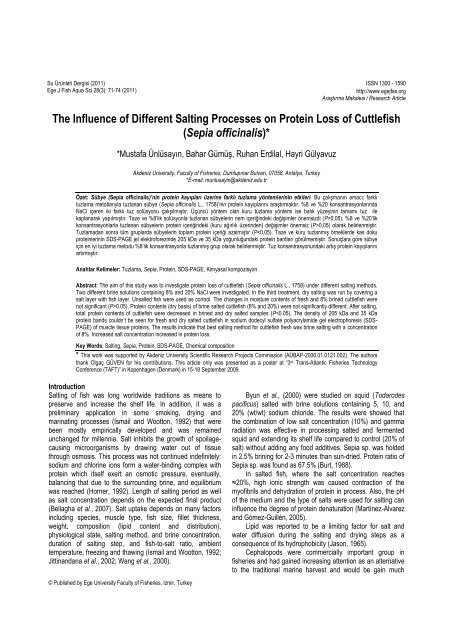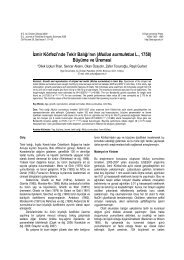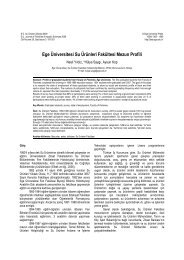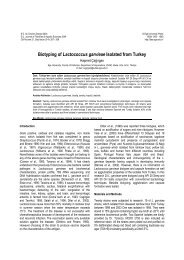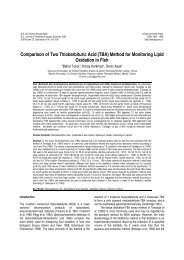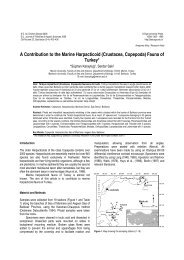Sepia officinalis - Journal of Fisheries and Aquatic Sciences
Sepia officinalis - Journal of Fisheries and Aquatic Sciences
Sepia officinalis - Journal of Fisheries and Aquatic Sciences
Create successful ePaper yourself
Turn your PDF publications into a flip-book with our unique Google optimized e-Paper software.
Su Ürünleri Dergisi (2011) ISSN 1300 - 1590<br />
Ege J Fish Aqua Sci 28(3): 71-74 (2011)<br />
http://www.egejfas.org<br />
Araştırma Makalesi / Research Article<br />
The Influence <strong>of</strong> Different Salting Processes on Protein Loss <strong>of</strong> Cuttlefish<br />
(<strong>Sepia</strong> <strong><strong>of</strong>ficinalis</strong>)*<br />
*Mustafa Ünlüsayın, Bahar Gümüş, Ruhan Erdilal, Hayri Gülyavuz<br />
Akdeniz University, Faculty <strong>of</strong> <strong>Fisheries</strong>, Dumlupınar Bulvarı, 07058, Antalya, Turkey<br />
*E-mail: munlusayin@akdeniz.edu.tr<br />
Özet: Sübye (<strong>Sepia</strong> <strong><strong>of</strong>ficinalis</strong>)’nin protein kayıpları üzerine farklı tuzlama yöntemlerinin etkileri. Bu çalışmanın amacı; farklı<br />
tuzlama metotlarıyla tuzlanan sübye (<strong>Sepia</strong> <strong><strong>of</strong>ficinalis</strong> L., 1758)’nin protein kayıplarını araştırmaktır. %8 ve %20 konsantrasyonlarında<br />
NaCl içeren iki farklı tuz solüsyonu çalışılmıştır. Üçüncü yöntem olan kuru tuzlama yöntemi ise balık yüzeyinin tamamı tuz ile<br />
kaplanarak yapılmıştır. Taze ve %8’lik solüsyonla tuzlanan sübyelerin nem içeriğindeki değişimler önemsizdi (P>0,05). %8 ve %20’lik<br />
konsantrasyonlarla tuzlanan sübyelerin protein içeriğindeki (kuru ağırlık üzerinden) değişimler önemsiz (P>0,05) olarak belirlenmiştir.<br />
Tuzlamadan sonra tüm gruplarda sübyelerin toplam protein içeriği azalmıştır (P0.05). Protein contents (dry basis) <strong>of</strong> brine salted cuttlefish (8% <strong>and</strong> 20%) were not significantly different. After salting,<br />
total protein contents <strong>of</strong> cuttlefish were decreased in brined <strong>and</strong> dry salted samples (P
72<br />
Ünlüsayın et al., Ege J Fish Aqua Sci 28(3): 71-74 (2011)<br />
larger importance in the future to supply mankind with marine<br />
living resources (Piatowski et al., 2001). Total cephalopod<br />
l<strong>and</strong>ings were increased steadily since 1950s (FAO, 2005).<br />
The aim <strong>of</strong> the preset study was to determine the effects<br />
<strong>of</strong> salting on cuttlefish flesh as a preprocessing before smoked<br />
<strong>and</strong> also the protein loss <strong>of</strong> species with different salting<br />
methods. Determination <strong>of</strong> the best salting method as a<br />
preliminary application for processing was crucial to avoid<br />
nutrient loss.<br />
Materials <strong>and</strong> Methods<br />
Common cuttlefish (<strong>Sepia</strong> <strong><strong>of</strong>ficinalis</strong> L., 1758) was used for<br />
this investigation. Cuttlefish were gillnetted with local<br />
fisherman from Boğazkent, (Serik-Antalya, Turkey) in April-<br />
2007. Mean total body mass <strong>and</strong> mantle length <strong>of</strong> individuals<br />
were 98.6±17.7 g <strong>and</strong> 9.2±0.5 cm, respectively. Samples<br />
were then transported to laboratory in polystyrene boxes in<br />
crushed ice during approximately 60 min. Totally, for<br />
treatments <strong>of</strong> 30 common cuttlefish each were used for 4<br />
different treatments.<br />
The viscera, head <strong>and</strong> arms <strong>of</strong> the cuttlefishes were<br />
removed <strong>and</strong> mantles were washed with water. Salt, also<br />
known as rock salt, is a crystalline mineral that is composed<br />
primarily <strong>of</strong> sodium chloride (NaCl) <strong>and</strong> that used for salting<br />
process was purchased from local market (Antalya). The salt<br />
processes (salt concentration, ratio <strong>of</strong> cuttlefish to brine) were<br />
chosen based on seafood industrial practices <strong>of</strong> the firms<br />
(Antalya-Turkey) as follows. Brine salting <strong>and</strong> dry salting<br />
processes were conducted in plastic containers at 4±1ºC. The<br />
concentrations <strong>of</strong> salt in brine solutions were 8% (R) <strong>and</strong> 20%<br />
(W) (w/w), <strong>and</strong> curing processes using these brine<br />
concentrations with a fish to brine ratio <strong>of</strong> 1:1 were carried out<br />
for a period <strong>of</strong> 6 h <strong>and</strong> 45 min respectively. Dry salting (D) was<br />
run for 12 h <strong>and</strong> salting process was carried by covering the<br />
surface <strong>of</strong> fish. Thereby squid was inserted into a salt layer.<br />
After the curing process salted mantles <strong>of</strong> the cuttlefishes<br />
were then used for the analysis. Unsalted fish were used as<br />
control. pH was measured in the dorsal muscle with a digital<br />
electronic pH meter with a glass electrode (WTW Mark, 320,<br />
Germany).<br />
The chemical contents <strong>of</strong> common cuttlefish flesh <strong>and</strong><br />
extract were determined according to Official Methods <strong>of</strong><br />
Analysis. Moisture contents were in fish flesh determined<br />
according to method 950.46 (AOAC, 2002a). Crude protein<br />
content (Nx6.25) was calculated using the Kjeldahl method<br />
(AOAC, 2002b). Lipid (fat) content was determined according<br />
to Soxhlet method (AOAC, 2002c). Crude ash (Inorganic<br />
matter in meat) was determined according to method 920.153<br />
(AOAC, 2002d). Sodium chloride was determined by<br />
volumetric method (AOAC, 1995). Solid matter in extract was<br />
determined according to Gravimetric method 952.08 (AOAC,<br />
2002a). After the water in extract was removed, crude ash in<br />
extract was calculated according to method Official Methods<br />
<strong>of</strong> Analysis (AOAC, 2002d) <strong>and</strong> the organic matter in extract<br />
was calculated by using the following formula:<br />
Organic matter in extract (%) = 100 – Crude ash in extract.<br />
A total <strong>of</strong> 1.5 g minced muscle tissue <strong>of</strong> cuttlefish were<br />
homogenised at 4°C for 1 min in 9.5 ml physiological saline<br />
(0.9% NaCl) with a mechanical homogenizer (Heidolph, Slient<br />
Crusher M model, Heidolph Instruments GmbH & Co KG,<br />
Germany), dialled to setting 6. Samples were stirred<br />
constantly for 20 min at 2°C then centrifuged at 5000 rpm for<br />
25 minutes at 4°C in an Elektromag (4808p, İkitelli OSB,<br />
İstanbul, Turkey). Protein concentration was determined in the<br />
supernatant by kit method (Lowry et al., 1951), (Protein<br />
Determination without Protein Precipitation Procedure; Sigma,<br />
Code TP0300 <strong>and</strong> L3540). Optical density was measured at<br />
650 nm in Chebios UV/ spectrophotometer (Optimum-One,<br />
Chebios s.r.l., Roma, Italy). The remainder <strong>of</strong> the supernatant<br />
was freeze-dried <strong>and</strong> kept at -18°C for further analysis.<br />
Discontinuous PAGE was prepared dilution <strong>of</strong> a 30%<br />
stock solution <strong>of</strong> acrylamide where the total amount (T) <strong>of</strong><br />
acrylamide+bis was 2% for the stacking gel <strong>and</strong> 5.1% for<br />
resolving gel. Freeze dried protein samples were reconstituted<br />
in Laemmli (1970) sample buffer to achieve the protein<br />
concentration <strong>of</strong> 13 microgram/microliter <strong>and</strong> loaded in each<br />
well <strong>of</strong> the gels. Electrophoresis (Mini-Protean II/Bio-Rad) was<br />
carried out at 35 mA one slab until the tracking dye reached<br />
the bottom <strong>of</strong> the gel (3h) in chamber with cooling to<br />
approximately 10°C. The molecular weight <strong>of</strong> each protein<br />
b<strong>and</strong> could then be calculated according to the st<strong>and</strong>ard curve<br />
<strong>of</strong> purified wide range marker proteins including aprotinin,<br />
bovine lung (6.5 kDa), α-lactalbumin, bovine milk (14.2 kDa),<br />
trypsin inhibitor, soybean (20 kDa), trypsinogen, bovine<br />
pancreas (24 kDa), carbonic anhydrase, bovine erythrocytes<br />
(29 kDa), glyceraldehyde-3-phosphate dehydrogenase, rabbit<br />
muscle (36 kDa), ovalbumin, chicken egg (45 kDa), glutamic<br />
dehydrogenase, bovine liver (55 kDa), albumin, bovine serum<br />
(66 kDa), phosphorylase B, rabbit muscle (97 kDa), β-<br />
galactosidase, E. coli (116 kDa), myosin, rabbit muscle (205<br />
kDa) from Sigma (Cat. No: M. S8445). Following<br />
electrophoresis, gels were stained with 0.04 % comassie blue<br />
R-250 in 2-propanol: acetic acid: water (25:10:65) overnight at<br />
room temperature. Excess stain was removed with several<br />
washes <strong>of</strong> the same solution without comassie blue R-250.<br />
Picture <strong>of</strong> them were taken in 7% acetic acid while they were<br />
still wet.<br />
Statistical analyses were performed using “SPSS 10.0 for<br />
Windows s<strong>of</strong>tware” (SPSS Inc, Chicago, IL). Differences in the<br />
means between groups were analysed by one-way ANOVA.<br />
Two-tailed P values were used, <strong>and</strong> statistical significance<br />
was set to P
The influence <strong>of</strong> different salting processes on protein loss <strong>of</strong> cuttlefish (<strong>Sepia</strong> <strong><strong>of</strong>ficinalis</strong>) 73<br />
fresh cuttlefish reported by Özoğul et al., (2008) were<br />
81.02±0.18% in spring, 78.02±0.21% in autumn, <strong>and</strong> 79.51 ±<br />
0.28% in winter. Özoğul (2012) also reported mantle <strong>of</strong><br />
cuttlefish caught from the Gulf <strong>of</strong> Mersin had high protein<br />
(22.20% for female <strong>and</strong> 22.15% for male) <strong>and</strong> low fat contents<br />
(0.86% for female <strong>and</strong> 1.01% for male). Zlatanos et al., (2006)<br />
reported moisture content <strong>of</strong> 81.2±2.0%. Changes in protein<br />
content <strong>of</strong> cuttlefish salted with 8% <strong>and</strong> 20% salt were similar<br />
<strong>and</strong> after the salting process, the crude protein content<br />
decreased than the fresh samples, owing to the muscle<br />
protein lost into the extract. Loss <strong>of</strong> protein for dry salted<br />
samples is more than brine salted samples (Table 1). The lipid<br />
content <strong>of</strong> species was found to be very low <strong>and</strong> species was<br />
all considered as lean. The results indicate that this<br />
cephalopod species is excellent protein sources <strong>and</strong> has low<br />
fat content. These results are supported by the findings <strong>of</strong><br />
other researchers (Özoğul et al., 2008; Zlatanos et al., 2006).<br />
Because <strong>of</strong> the low lipid content <strong>of</strong> cuttlefish meat, changes in<br />
lipid content after salting were insignificant (P>0.05).<br />
Table 1. Chemical composition <strong>of</strong> cuttlefish samples<br />
Part <strong>of</strong> cuttlefish Analysis OC OR OW OD<br />
Moisture (%) 77.40±0.25 a 76.36±0.42 a 73.04±1.02 b 67.62±1.47 c<br />
Dry Matter (%) 22.60±0.25 c 23.64±0.42 c 26.96±1.02 b 32.38±1.47 a<br />
Protein (%) 84.81±2.49 a 73.90±2.42 b 72.81±6.23 b 54.92±2.07 c<br />
Flesh Lipid (%) 5.65±1.94 a 4.66±1.25 a 5.71±1.77 a 3.86±0.43 a<br />
Ash (%) 7.19±2.13 b 18.52±2.20 a 16.48±2.21 a 19.03±1.11 a<br />
pH 6.75±0.13 a 6.44±0.09 b 6.60±0.07 ab 6.45±0.20 b<br />
NaCl (%) ― 14.56±1.19 b 15.15±0.63 b 17.40±0.66 a<br />
Solid Matter (%) ― 6.66±1.24 b 16.75±0.24 a 8.25±2.08 b<br />
Extract Inorganic Matter (%) ― 12.01±2.79 b 20.67±4.58 a 19.28±1.13 a<br />
Lipid (%) ― 1.02±0.07 a 1.01±0.05 a 0.98±0.06 a<br />
Values are shown as mean ± st<strong>and</strong>ard deviation <strong>of</strong> triplicate measurements.<br />
Different superscript letters in the same row indicate significant differences between groups (P
74<br />
Ünlüsayın et al., Ege J Fish Aqua Sci 28(3): 71-74 (2011)<br />
Figure 1. SDS-PAGE <strong>of</strong> muscle proteins <strong>of</strong> fresh, brine salted <strong>and</strong> dry salted<br />
cuttlefish samples.<br />
OC; Fresh cuttlefish., OR; Brine salted 8% (w/w) cuttlefish meat OW; Brine<br />
salted 20% (w/w) cuttlefish meat, OD; Dry salted cuttlefish meat<br />
Electrophoretic pr<strong>of</strong>iles <strong>of</strong> proteins released into various<br />
cuttlefish samples were shown in Figure 1. The density <strong>of</strong> 205<br />
kDa <strong>and</strong> 36 kDa protein b<strong>and</strong>s couldn’t be seen for both fresh<br />
<strong>and</strong> dry salted cuttlefish. All the other protein b<strong>and</strong>s (150, 118,<br />
106, 67, 48, 38 <strong>and</strong> 31) can be seen for all brine methods. In<br />
this respect, protein b<strong>and</strong>ing patterns <strong>of</strong> different salted<br />
samples <strong>of</strong> cuttlefish resembled each other.<br />
Conclusion<br />
Salting process with 8% brine seems to be the best for<br />
cuttlefish samples because <strong>of</strong> the minimum loss <strong>of</strong> organic<br />
material. For both brining with 20% solution <strong>and</strong> dry salting,<br />
organic material losses have been determined. Although<br />
protein content changed depending on the concentration <strong>of</strong><br />
salt solution lipid content did not change. Our results may<br />
imply that the increase in salt concentration was effective in<br />
respect <strong>of</strong> the extract loss <strong>of</strong> common cuttlefish. Low lipid<br />
content <strong>of</strong> cuttlefish meat causes more water loss <strong>and</strong> salt<br />
diffusion at salt concentrations. Consequently we don’t<br />
recommend salting with high salt concentrations as a<br />
preliminary operation for processing for cephalopod species.<br />
References<br />
Association <strong>of</strong> Official Analytical Chemists. 1995. Salt (Chlorine as Sodium<br />
Chloride) in Meat. 935.47. Official methods <strong>of</strong> analysis (15 th edition).<br />
Gaithersburg. Maryl<strong>and</strong>.<br />
Association <strong>of</strong> Official Analytical Chemists. 2002a. Moisture content. 950.46.<br />
Official Methods <strong>of</strong> Analysis (17th edition). Gaithersburg. Maryl<strong>and</strong>.<br />
Association <strong>of</strong> Official Analytical Chemists. 2002b. Protein content in meat.<br />
928.08. Official Methods <strong>of</strong> Analysis (17th edition). Gaithersburg.<br />
Maryl<strong>and</strong>.<br />
Association <strong>of</strong> Official Analytical Chemists. 2002c. Fat content in meat.<br />
960.39. Official Methods <strong>of</strong> Analysis (17th edition). Gaithersburg.<br />
Maryl<strong>and</strong>.<br />
Association <strong>of</strong> Official Analytical Chemists. 2002d. Ashes content. 920.153.<br />
Official Methods <strong>of</strong> Analysis (17th edition). Gaithersburg. Maryl<strong>and</strong>.<br />
Bellagha, S., Sahli, A., Farhat, A., Kechaou, N., Glenza, A. 2007. Studies on<br />
salting <strong>and</strong> drying <strong>of</strong> sardine (Sardinella aurita): Experimental kinetics<br />
<strong>and</strong> modelling. <strong>Journal</strong> <strong>of</strong> Food Engineering, 78:947-952.<br />
Burt, J.R. 1988. Fish Smoking <strong>and</strong> Drying. Elsevier Science Publishers Ltd.,<br />
London, Engl<strong>and</strong>.<br />
Byun, M.W., Lee, K.H., Kim, D.H., Kim, J.H., Yook, H.S., Ahn, H.J. 2000.<br />
Effects <strong>of</strong> gamma radiation on sensory qualities, microbiological <strong>and</strong><br />
chemical properties <strong>of</strong> salted <strong>and</strong> fermented squid. <strong>Journal</strong> <strong>of</strong> Food<br />
Protection, 63:934-939.<br />
FAO. 2005. The State <strong>of</strong> the World <strong>Fisheries</strong> <strong>and</strong> Aquaculture, 2005. FAO,<br />
Rome, Italy.<br />
Horner, W.F.A. 1997. Salting. In: Fish Processing Technology Preservation <strong>of</strong><br />
Fish by Curing, Hall, G.M. (ed). Chapman&Hall Publishers, UK, 32-72.<br />
Ismail, N., Wootton, M. 1992. Fish salting <strong>and</strong> drying: a review. Asian Food<br />
Joournal, 7:175-183.<br />
Jason, A.C. 1965. Effects <strong>of</strong> fat content on diffusion <strong>of</strong> water in fish muscle.<br />
<strong>Journal</strong> Science <strong>and</strong> Food Agricultural, 16:281-288.<br />
Jittin<strong>and</strong>ana, S., Kenney, P.B., Slider, S.D., Kiser, R.A. 2002. Effect <strong>of</strong> brine<br />
concentration <strong>and</strong> brining time on quality <strong>of</strong> smoked rainbow trout fillet.<br />
<strong>Journal</strong> <strong>of</strong> Food Science, 67:2095-2099.<br />
Laemmli, U.K. 1970. Cleavage <strong>of</strong> structural proteins during the assembly <strong>of</strong><br />
the heat <strong>of</strong> bacteriophage T4. Nature, 227:680-685.<br />
Lowry, O.H., Rosenbrough, N.J., Farr, A.L., R<strong>and</strong>all, R.J. 1951. Protein<br />
measurement with the folin phenol reagent. <strong>Journal</strong> <strong>of</strong> Biochemistry,<br />
193:265-275.<br />
Martínez-Alvarez, O., Gόmez-Guillén, M.C. 2005. The effect <strong>of</strong> brine<br />
composition <strong>and</strong> pH on the yield <strong>and</strong> nature <strong>of</strong> water-soluble proteins<br />
extractable from brined muscle <strong>of</strong> cod (Gadus morhua). Food<br />
Chemistry, 92:71-77.<br />
Martínez-Alvarez, O., Gόmez-Guillén, M.C. 2006. Effect <strong>of</strong> brine salting at<br />
different pHs on the functional properties <strong>of</strong> cod muscle proteins after<br />
subsequent dry salting. Food Chemistry, 94:123-129.<br />
Özoğul, Y., Duysak, O., Özoğul, F., Özkütük, A.S., Türeli, C. 2008. Seasonal<br />
effects in the nutritional quality <strong>of</strong> the body structural tissue <strong>of</strong><br />
cephalopods. Food Chemistry, 108:847-852.<br />
Özoğul, Y. 2012. The chemical composition <strong>and</strong> meat yield <strong>of</strong> sexually mature<br />
cuttlefish (<strong>Sepia</strong> <strong><strong>of</strong>ficinalis</strong>). <strong>Journal</strong> <strong>of</strong> <strong>Fisheries</strong> <strong>Sciences</strong>.com, 6(2):99-<br />
106.<br />
Piatowski, U., Pierce, G.J., Morais, D.A., Cunha, M. 2001. Impact <strong>of</strong><br />
cephalopods in the food chain <strong>and</strong> their interaction with the<br />
environment <strong>and</strong> fisheries. <strong>Fisheries</strong> Research, 52:5-10.<br />
Sannaveerappa, T., Ammu, K., Joseph, J. 2004. Protein-related changes<br />
during salting <strong>of</strong> milkfish (Chanos chanos). <strong>Journal</strong> <strong>of</strong> Science Food<br />
<strong>and</strong> Agricultural, 84:863-869.<br />
Ünlüsayın, M., Kaleli, S., Gülyavuz, H. 2001. The determination <strong>of</strong> flesh<br />
productivity <strong>and</strong> protein components <strong>of</strong> some fish species after hot<br />
smoking. <strong>Journal</strong> <strong>of</strong> Science Food <strong>and</strong> Agricultural, 81:661-664.<br />
Wang, D., Tang, J., Correia, L.R. 2000. Salt diffusivities <strong>and</strong> salt diffusion in<br />
farmed Atlantic salmon muscle as influenced by rigor mortis. <strong>Journal</strong> <strong>of</strong><br />
Food Engineering, 43:115-123.<br />
Zlatonos, S., Laskaridis, K., Feist, C., Sagredos, A. 2006. Proximate<br />
composition, fatty acid analysis <strong>and</strong> protein digestibility-corrected score <strong>of</strong><br />
three Mediterranean cephalopods. Molecular Nutrition Food Research,<br />
50:967-970.


